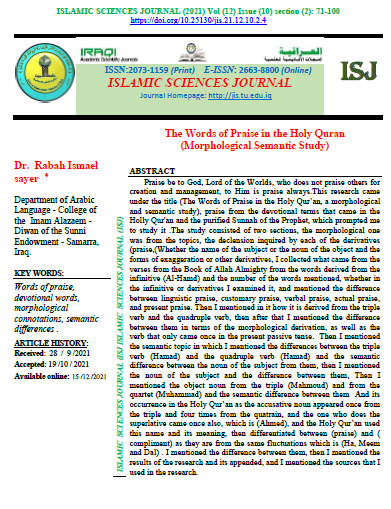The Words of Praise in the Holy Quran (Morphological Semantic Study)
محتوى المقالة الرئيسي
الملخص
ABSTRACT
Praise be to God, Lord of the Worlds, who does not praise others for creation and management, to Him is praise always.This research came under the title (The Words of Praise in the Holy Qur’an, a morphological and semantic study), praise from the devotional terms that came in the Holly Qur'an and the purified Sunnah of the Prophet, which prompted me to study it. The study consisted of two sections, the morphological one was from the topics, the declension inquired by each of the derivatives (praise),Whether the name of the subject or the noun of the object and the forms of exaggeration or other derivatives, I collected what came from the verses from the Book of Allah Almighty from the words derived from the infinitive (Al-Hamd) and the number of the words mentioned, whether in the infinitive or derivatives I examined it, and mentioned the difference between linguistic praise, customary praise, verbal praise, actual praise, and present praise. Then I mentioned in it how it is derived from the triple verb and the quadruple verb, then after that I mentioned the difference between them in terms of the morphological derivation, as well as the verb that only came once in the present passive tense. Then I mentioned the semantic topic in which I mentioned the differences between the triple verb (Hamad) and the quadruple verb (Hamad) and the semantic difference between the noun of the subject from them, then I mentioned the noun of the subject and the difference between them, Then I mentioned the object noun from the triple (Mahmoud) and from the quartet (Muhammad) and the semantic difference between them And its occurrence in the Holy Qur’an as the accusative noun appeared once from the triple and four times from the quatrain, and the one who does the superlative came once also, which is (Ahmed), and the Holy Qur’an used this name and its meaning, then differentiated between (praise) and ( compliment) as they are from the same fluctuations which is (Ha, Meem and Dal) . I mentioned the difference between them, then I mentioned the results of the research and its appended, and I mentioned the sources that I used in the research.
تفاصيل المقالة

هذا العمل مرخص بموجب Creative Commons Attribution 4.0 International License.
COLLEGE OF ISLAMIC SCIENCES, TIKRIT UNIVERSITY. THIS IS AN OPEN ACCESS ARTICLE UNDER THE CC BY LICENSE http://creativecommons.org/licenses/by/4.0/

